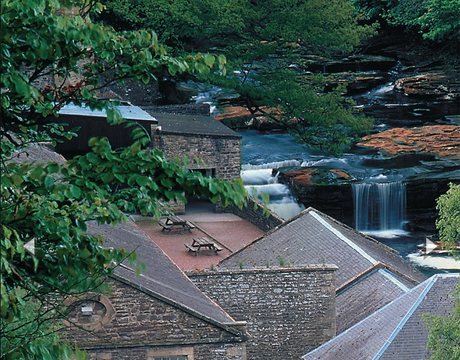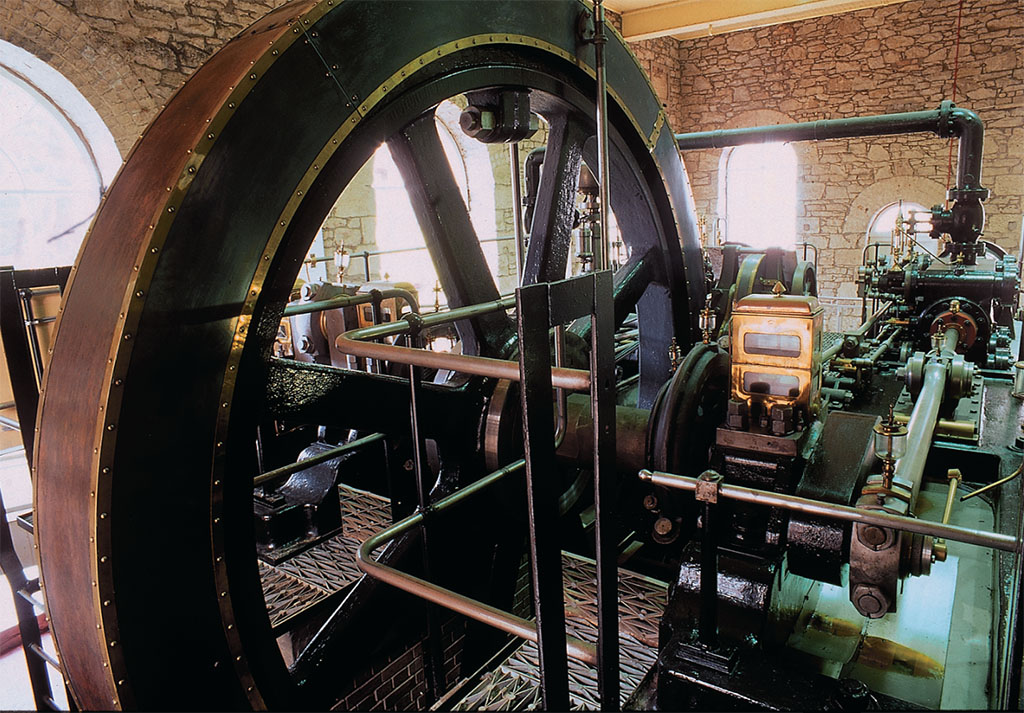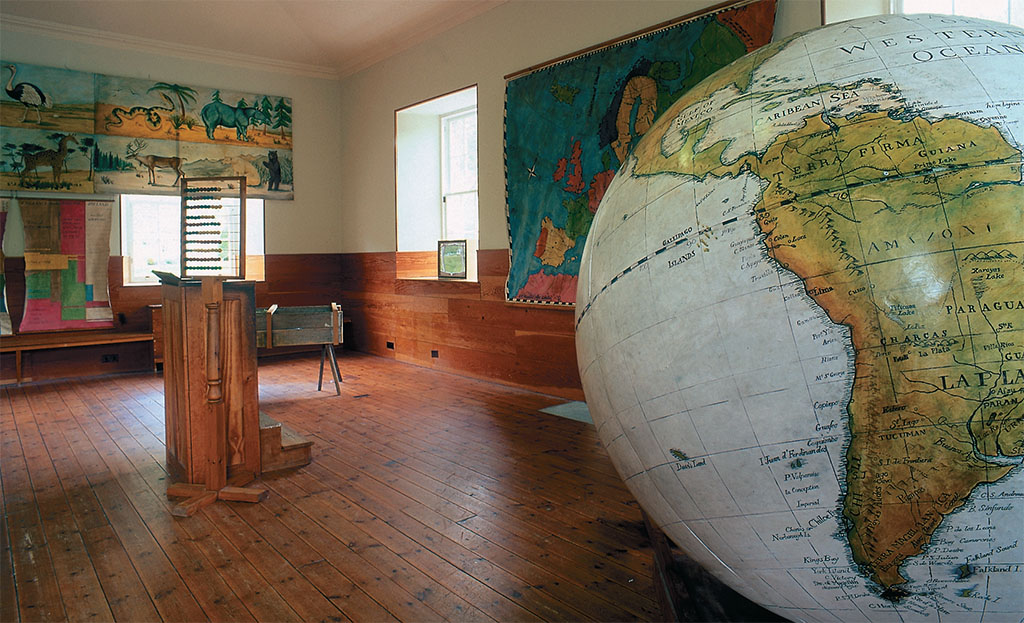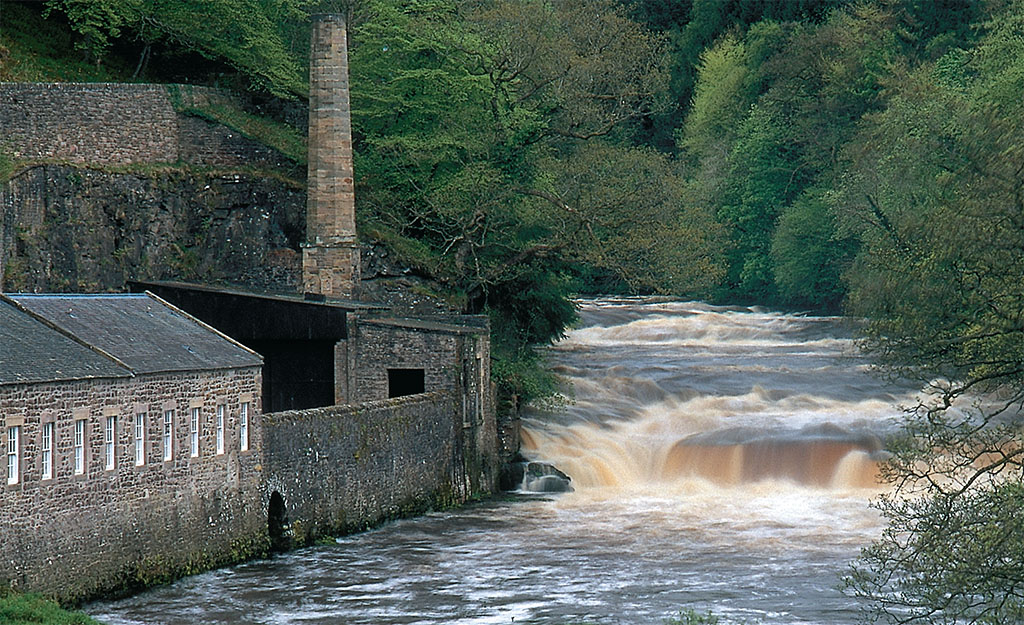
Cascading water from the pretty River Clyde provided power to the 18th-century mills of New Lanark.
Decent homes, fair wages, and the first nursery school in the world.
In 1785, when David Dale started his cotton-spinning factory, New Lanark, he emptied the orphanages of nearby Glasgow. He employed 795 children and just 362 adults; 450 of the children were not yet in their teens, and more than 100 were under eight. That, of course, was the whole point of the newly created factory system (invented only 14 years earlier) that Dale was introducing to Scotland. Rather than requiring skilled craftsmen, factories could use labor so unskilled that tiny children would do fine.
Dale’s orphans were unpaid, working 13 hours a day for room, board, and two hours of mandatory education after work. Times were so bad, however, that Dale was widely hailed as a civic benefactor. In fact, Dale treated his orphans so well that only nine died over the next 15 years. The rest grew up to be healthy, literate adults, far better off than they could have expected to become back in Glasgow.
Read more: A room with a view - taking in the historic Scottish city of Edinburgh
Today New Lanark is a World Heritage Site, an industrial museum fully restored to its original condition. It consists of 16 elegant structures made of local sandstone, stretched out in shelves along the bottom of the River Clyde’s beautiful gorge. The largest structures, long and tall, are the mills, home to the exhibits. These are flanked by long rows of terrace cottages, still in use, and some occupied by the last generation of mill workers (the mills closed in 1968). It’s an attractive and remarkable place—but that’s not why it’s famous; it’s because its second owner was the idealist, labor reformer, and purported Father of Socialism, Robert Owen.
Born a poor Welshman, Owen combined high intelligence with a talent for self-promotion. He left home at age 11 to work as a London factory laborer; within eight years had become manager of a Manchester textile mill. At 27, in 1798, Owen was already hatching ideas of social reform and was looking for a position that would give him scope. He heard of Dale’s philanthropic factory at New Lanark and paid a visit. Owen caught Dale’s eldest daughter’s eye, and a year later became the boss’ son-in-law. By 1801, Owen had taken over the factory, having organized investors to buy out Dale.

Jim Hargan
David Dale’s New Lanark had been a pioneering effort among the early factories. Before factories, manufacturing had been farmed out to skilled crafters who would perform the work in their cottages for a set fee per piece; factories replaced the cottage system with mass production. A skilled craft would be broken into distinct, repetitive steps, aided by machinery, with a single laborer doing each step. Water wheels provided the immense of amount of power required to run the machinery, with their energy transmitted to the machines by belts linked to central shafts. This new method required a complete reorganization of labor; the entire labor force had to be gathered into a giant mill designed around the long, spinning shafts. A factory of this sort needed two things: a powerful head of water and a large workforce within walking distance. Factory owners had a hard time finding both at one place, and labor was a lot easier to relocate than a waterfall.

Providing mandatory education for the children who worked the New Lanark mills, the school is today equipped and furnished as it was in Robert Owen’s time. Jim Hargan
Dale put his New Lanark mill in a remote river gorge because it was a superb spot for water power. He then created a village around it, isolated deep in the gorge, built in Palladian-inspired architecture lining the millstream. The millstream is still there, and part of it still flows over a large water wheel, demonstrating the early power source. In the 19th century, a steam engine was added to supplement direct water power, but was seldom used; today it sits, two stories tall and fully restored, in the midst of the largest mill. Water still powers the complex, in the form of a hydroelectric turbine installed in the 1930s, also on exhibit.
Read more: Take a virtual tour of Britains top tourist attractions during quarantine
As a mill owner, Robert Owen was not so much an incipient socialist as an enlightened capitalist. By Owen’s day, the factory system was 30 years old; factories were common, though few owners were as benevolent as Dale or Owen. Owners confronted a sullen, unhealthy, lazy, and largely illiterate workforce that had to be beaten into working and who quit all the time. Owen approached labor problems systematically. He had his supervisors carefully measure every worker’s output and used a system of painted blocks, visible to all, to track individual productivity. Yelling and beating were prohibited and unneeded; slackers were easily and accurately identified, and quickly fired. The workplace became calm and focused. Owen hired a night security force to patrol the streets of the village; drunks were fired on the third offense, and noise and disruption ended. He funded a company doctor and infirmary.
Managers, including Owen for the first few years, lived within the village and were a part of its life. He introduced a company store at the heart of the village, where workers could buy high-quality groceries at near-wholesale prices; Owen’s store gave him a well-fed workforce at no additional cost. And he proved his point: his healthy, literate, dedicated and loyal workforce produced ample profits for Owen and his investors.

The water pouring down the gorge of the River Clyde even in flood runs much clearer and cleaner than it did at the turn of the 19th century. Jim Hargan
With sympathetic new partners who were willing to cut him some slack, Owen introduced his greatest innovation in 1816. Increasingly radical and already popular on the lecture circuit, Owen had developed a theory for improving humanity using childhood education. To implement this, he eliminated all labor for children under 10; everyone from the age of 18 months would spend their day in school, incidentally leaving their mothers free to work in the factory. This was not, however, the dull drudgery of Victorian (or modern) times. It was fun.
Students would don the school uniform, a plain cotton tunic, and then start the day with dancing and singing. Love of nature and music were foremost, with science, history and geography stressed; the “Three Rs” were taught, but deemphasized. Vast maps and even bigger pictures of animals covered the walls of the bright, airy classroom, and a huge globe, twice the height of the largest child, dominated its center. Sunny weather would bring students and teachers outside for games or field trips. There was no punishment and no reward; each student set their own pace and found their own motives. The school, however, was Owen’s downfall. In 1825 prudish Quaker investors objected to the drape-like uniforms (they showed too much leg), and Owen quit in a huff. He went on to lose his fortune in Utopian experiments and then to campaign for his increasingly wild theories. But his days as a capitalist, enlightened or otherwise, were over.
Modern New Lanark is an impressive place; its warm stone and harmonious design balances the epic scale of its construction. Here you’ll find plenty to fill a day. Two terrace cottages are open, one furnished as in Owen’s day and another as in the 1930s, and Owen’s house has been restored as well. The main mill is filled with interest: you climb past the steam engine, then the ghost of a child worker guides you through exhibits, after which you pass working spinning jennies in operation, and finally walk out onto one of Scotland’s largest roof gardens, with stunning views. Gorge walks take you through forest to waterfalls. You can even stay there, at a luxury hotel, rental cottages or a youth hostel. But the best exhibit is the school, fully restored as if about to welcome students. You can stand in front of that enormous globe and imagine yourself a wee bairn in a remote village, seeing the entire Earth loom above you—understanding in wonder the true size of the world, as one of the first British working-class children to enjoy a childhood.
Planning Ahead
New Lanark is owned and operated by an independent not-for-profit organization, the New Lanark Conservation Trust. Complete information can be found at www.newlanark.org. The trust’s hotel on site is at www.newlanarkhotel.co.uk. This site contains a page about and a link to the youth hostel.
Read more: A Scottish road trip in search of Brigadoon





Comments